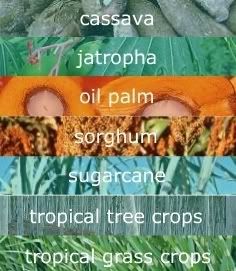News about tropical energy crops
 We are rapidly progressing towards a green energy future in which developing nations -- more particularly countries in the tropics and the sub-tropics -- are playing an ever increasing role. Because of this, we will begin to hear more and more about tropical energy crops that can be used to make solid and liquid biofuels.
We are rapidly progressing towards a green energy future in which developing nations -- more particularly countries in the tropics and the sub-tropics -- are playing an ever increasing role. Because of this, we will begin to hear more and more about tropical energy crops that can be used to make solid and liquid biofuels.We think it might be useful to offer news about those crops in a separate category (which can be found in the right bar of this blog). We will report about these crops with headlines on advances in biotechnology, green chemistry, agronomic news, biofuel programs, the expansion of hectarages, production data, breakthroughs in bioconversion processes using these crops, trade deals, export data and much more.
The following plants were selected, mainly because (we think) they will become the major energy crops of the future:
- Cassava (Manihot esculenta), also known as 'manioc'; a promising bioenergy crop which thrives in non-forest areas and which is relatively drought-tolerant. Cassava is a staple food for half a billion people, mainly in Africa and South East Asia.
- Jatropha (Jatropha curcas), known under many different names ('pinhao manso' in the lusophone world, 'tuba tuba' in South East Asia, or 'noix de pourghère' in the francophone world). Known for its tolerance to droughts, yields a good oil for biodiesel, and features in many national biofuels programs as the preferred crop.
- Oil palm (Elaeis guineensis), yielding more energy than any other crop (oil and solid biomass), and currently more competitive than any other crop. The expansion of oil palm plantations poses numerous environmental problems though.
- Sorghum, a family of drought-tolerant grass species the most interesting of which is sweet sorghum (Sorghum bicolor), already used widely for the production of alcohols. Sorghum is the fifth most widely grown food crop on earth, and is especially interesting because it is widely cultivated in semi-arid regions of Africa (the Sahel and the Southern African desert zone).
- Sugarcane, perhaps the best known biofuel crop, with Brazil's vast ethanol industry which is based on it, being the example for many countries. There is a lot of scientific research going on focusing on sugarcane, with developing countries playing a crucial role. It will be interesting to see how this crop expands further into the global South, now that Brazil has shown how to build a bio-economy around it.
- The market for solid biofuels is expanding rapidly, and globally. That is why we include information about 'tropical tree crops'. Some countries are already importing this kind of woody biomass from the south, to be used as a feedstock for biomass power plants, or to be co-fired with coal. We have limited ourselves to gathering news about the most promising tropical tree species, namely: eucalyptus, acacia and rubberwood.
- Finally, with the advent of second generation biofuels, more and more grass species are being identified as having great potential as feedstocks to be used under various 'biomass-to-liquid' conversion technologies (cellulosic ethanol, fast pyrolysis, gasification-to-liquids). Strictly speaking both sugarcane and sorghum are grasses, but in this category, we focus on herbaceous species that are only gradually being recognized as potential bioenergy crops and around which a great deal of research is going on: miscanthus and bamboo (genuses with many species and subspecies).
 cassava :: jatropha :: oil palm :: sorghum :: sugarcane :: eucalyptus :: acacia :: rubberwood :: bamboo :: miscanthus ::
cassava :: jatropha :: oil palm :: sorghum :: sugarcane :: eucalyptus :: acacia :: rubberwood :: bamboo :: miscanthus :: -------------------
-------------------
 Spanish company Ferry Group is to invest €42/US$55.2 million in a project for the production of biomass fuel pellets in Bulgaria.
The 3-year project consists of establishing plantations of paulownia trees near the city of Tran. Paulownia is a fast-growing tree used for the commercial production of fuel pellets.
Spanish company Ferry Group is to invest €42/US$55.2 million in a project for the production of biomass fuel pellets in Bulgaria.
The 3-year project consists of establishing plantations of paulownia trees near the city of Tran. Paulownia is a fast-growing tree used for the commercial production of fuel pellets.









0 Comments:
Post a Comment
Links to this post:
Create a Link
<< Home